ALL ABOUT THE MONEY
¸
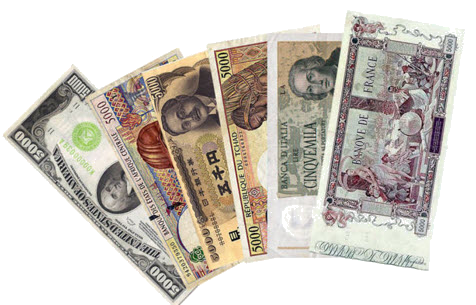
Paper Money from
Various Countries
Unit
Overview
Because
we cannot get the things we need and want without it, money is an essential
part of our daily lives. If asked, most
of us would define it as the bills in our wallets or as what we receive when we
cash our paychecks. It should come as no
surprise that economists have their own language when it comes to defining
money. In this unit, you will view money
from an economist’s perspective. What
gives money value? What are its
characteristics and functions? How does
it circulate throughout the economy?
Let’s see how it all works.
How an
Economist Defines Money
Almost
all societies have established a form of money to simplify financial
transactions. An economist defines money
as anything that provides a medium of exchange, a unit of account and a store
of value. If something is going to work
as money, it must be accepted by all parties as payment for goods and
services. In other words, an object has
to function as a medium of exchange
to be considered money. Workers must
agree to accept it in exchange for their labor, and merchants must agree to
accept it as payment for goods. Throughout
history, a wide variety of materials, such as gold dust, rice, salt and cattle,
have been used as a medium of exchange.
For
an article to be regarded as money, it must serve as a unit of account. This is
also referred to as measure of value.
This function assists consumers in comparing the values of goods and
services. For example, let’s say you see
a pair of running shoes on sale in a shop for $45.00. Because the price is expressed the same way
in every store in the United States, you can easily compare the cost of the
shoes if you see the same item offered elsewhere. Units of account provide a convenient and
easily understood method of identifying and communicating value. In the United States, dollars and cents operate
as units of account, but other countries use their own money for this purpose. For the Russians, the ruble is a unit of
account, while Mexicans use the peso in a similar way.
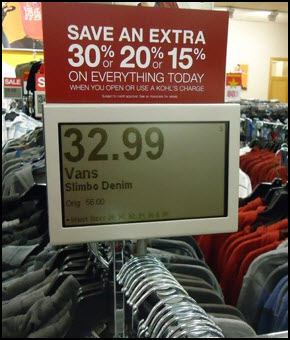
Price in Dollars and Cents Helps Buyers
to Compare Value
To
be considered money, an item must serve as a store of value. This means
that money maintains its value whether you spend it today or tomorrow. If you keep your money in your purse or in
the bank, it will still be a unit of account and recognized as a medium of
exchange for the same amount months or years from now. Money works well in this capacity with one
important exception. Sometimes economies
experience a quick rise in prices, or inflation. In this case, purchasing power declines. The running shoes that were once $45.00 are
now $55.00, and consumers are able to purchase less with their stored
funds. When an economy experiences
inflation, money does not function well as a store of value.
![]() Go to Questions 1
through 4.
Go to Questions 1
through 4.
Characteristics
of Money
Along
with having specific functions, objects used as money need to have certain
characteristics if they are going to serve society successfully. They must be durable, divisible, uniform,
portable, limited in supply and acceptable.
Because it is used over and over again, money must withstand physical
wear and tear. After all, it cannot be
trusted as a store of value if it is not durable. Coins are some of the longest-lasting
examples. In fact, Greek and Roman
coins, made over two thousand years ago, are highly prized by collectors
today. Because American paper money has
a high degree of cloth, or rag, content, it withstands the rigors of
circulation and can be easily replaced if it does not.
To
serve a practical purpose, buyers and sellers should be able to divide money
into smaller units simply. In the 1700s,
Spanish coins, called doubloons, had
lines etched on them so that they could be broken apart easily. Because these coins were designed to be divisible, Spaniards referred to them
as pieces of eight. Today, instead of
tearing dollars into smaller pieces, Americans address this issue by relying on
coins and paper bills that come in a variety of denominations. In other words, we do not need to cut up
twenty-dollar bills because we have ones, fives and tens. At the same time, money should also be uniform. Everyone must be able to count and to measure
it accurately. Each dollar is obliged to
buy the same amount of a good or a service.
What would happen if the U.S. economy adopted oak leaves as money? Because not all oak leaves are the same size,
consumers might spend one on one day and three on another day to purchase the
same product. This would probably result
in frequent arguments between buyers and sellers.
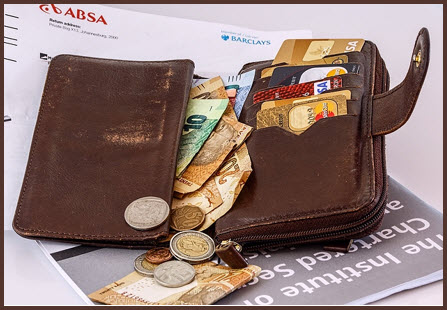
An Example of the Portability of Paper
Money and Coins
Portability
is one of the most necessary and practical characteristics of money. People first exchanged goods and services
through barter. This refers to the direct transfer of one
product for another. Although it is
still currently used in some parts of the world, specialized economies find the
practice difficult and time-consuming.
To conduct business efficiently, buyers and sellers need to take their
money with them. In other words, money
is more useful when it is portable. Since coins and paper bills are small and
easily carried, they have a distinct advantage over bartered goods. Everyone in the economy needs to be able to
trade the objects serving as money for goods and services. This means that money must be acceptable across the country. In the United States, store owners accept
American money because they can spend it anywhere to buy things that they want
our need. At the same time, Americans
expect that businesses will continue to honor paper money when they make
purchases.
Like
almost everything else, money loses its value when there is too much or too
little of it. In colonial Virginia, for
example, tobacco functioned as money.
This worked reasonably well until more farmers started to grow it. As the supply of tobacco increased, the price
dropped from thirty-six cents per pound to one cent per pound. This made “tobacco money” worthless. To avoid situations like this, the U.S.
government controls the amount of money in circulation through the Federal
Reserve. This gives money value because
the supply is limited. The Federal Reserve keeps enough money in
circulation to encourage economic growth.
It can also decrease the amount money in circulation to avoid inflation.
![]() Go to Questions 5 through 9.
Go to Questions 5 through 9.
What
Makes Money Valuable?
Although
paper bills are practical objects, they have little value of their own. In reality, they are only pieces of
paper. What makes the objects used as
money special, and why do we regard them as valuable? There are several possible answers because
there are different kinds of money.
Economists divide money into three types: commodity money, representative money and
fiat money.
Ø Commodity money:
Commodity money consists of objects that are not only useful as money
but also have value in their own right.
You read earlier that tobacco was used as money in colonial Virginia. However, it could also be traded as a
product. Salt is another example. Although it, too, served as money, it also
had value as a seasoning and as a preservative.
Commodity money has the advantage of being functional in other ways when
it is not being used as money. However,
it also has drawbacks. Commodity money
is often not durable, divisible or portable.
As societies grow and become more sophisticated, they usually require a
more convenient system for the exchange of goods and services.
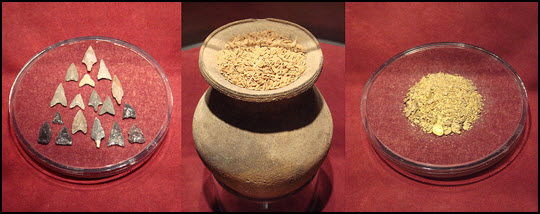
Examples of Items Used as Commodity
Money: Arrow heads, Rice and Gold Dust
Ø Representative money:
Unlike
commodity money, representative money has no value itself, but it stands for
something that does. In the 1800s, the
United States government began to issue gold and silver certificates. These pieces of paper were backed by actual
gold and silver, and holders could redeem them for an equal amount of these precious
metals at a local bank. In 1900,
Congress passed the Gold Standard Act.
This law fixed the price of gold at $20.67 and obligated the federal
government to exchange dollars for gold at that rate. Americans felt more secure knowing that their
money represented gold in the National Treasury. The 1930s, however, ushered in uncertainty,
unemployment and a record number of bank failures. Americans no longer trusted banks to keep
their money safe and redeemed cash for gold.
The federal government feared that it did not have enough reserves to
meet the public’s demands. In 1933,
President Franklin Roosevelt declared a national emergency, and America went
off the gold standard. U.S. money was no
longer representative.
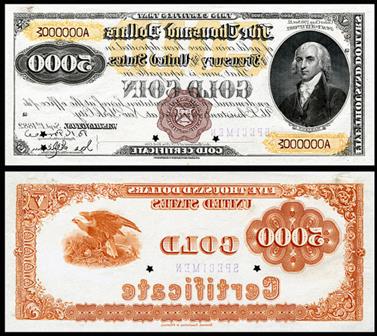
U.S. Gold Certificate
Ø Fiat money:
American dollars and coins today are classified as fiat money. A fiat
is an order or a decree. Also referred
to as legal tender, fiat money has
value because the federal government says that it does. The Federal Reserve
monitors the supply of fiat money carefully so that it remains limited and,
therefore, valuable.
![]() Go to Questions 10
through 13.
Go to Questions 10
through 13.
Money
and the Circular Flow
In a
market economy, households, which
are made up of individuals living in the same residences, and firms, or businesses, exchange
resources, products and money in the marketplace. Economists use diagrams like the one below to
illustrate this process. Follow the
circle created by the blue arrows.
Households spend money to purchase goods and services from firms. Firms, in turn, use this money to pay
households for the resources that they need to manufacture their products. For example, companies hire workers to whom
they pay salaries, wages and benefits. This
outer circle is known as the monetary
flow. On the other hand, the green
arrows of the inner circle form the physical
flow, or the flow of resources. Households
supply firms with labor and capital, while firms supply households with goods
and services.
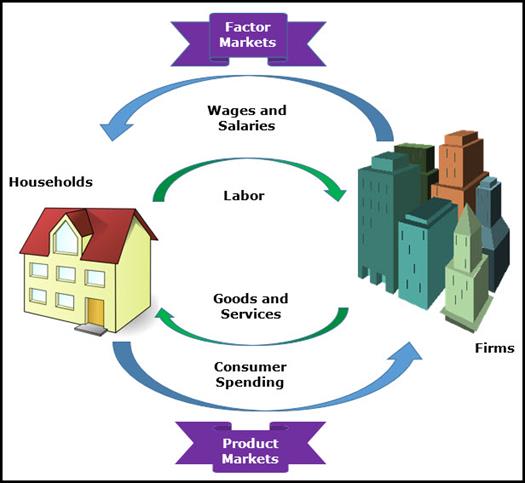
Let’s
look at the diagram another way. Focus
on the upper part of the graphic. It
represents the markets where resources are bought and sold. These are called factor markets because
businesses buy the factors of production in them. The lower portion of the diagram shows
households and firms interacting in product
markets. Here, households buy goods and services produced by firms. Once individuals receive their income in the
factor market, they spend it in the product market. Firms then use this money to produce more
goods and services. This creates a
continuous flow, or cycle.
![]() Go to Questions 14
through 17.
Go to Questions 14
through 17.
The
Future of Money
In
this unit, you have read about the functions and characteristics of money. Although paper bills and coins have their
advantages, some analysts argue that they will soon be obsolete. Will cash as we know it cease to exist in the
near future? Would it be better to replace
it with electronic money or smart cards?
Is cyber money a serious threat to our privacy? Read the opposing points of view quoted in
the graphic below.
|
The Pros and Cons of Eliminating
Paper Bills and Coins |
|
|
Bring on the Cashless Future |
The Hubris of Eliminating Cash |
|
Cash had a pretty good
run for 4,000 years or so. These days, though, notes and coins increasingly
seem outdated. They're dirty and dangerous, unwieldy and expensive,
antiquated and so very analog. Sensing
this dissatisfaction, entrepreneurs have introduced hundreds of digital
currencies. This is a welcome
trend. In theory, digital legal tender could combine the inventiveness of
private virtual currencies with the stability of a government mint. Most obviously, such a system would make
moving money easier. Properly designed, a digital fiat currency could move
seamlessly across otherwise incompatible payment networks, making
transactions faster and cheaper. It would be of particular use to the poor,
who could pay bills or accept payments online without need of a bank account,
or make remittances without getting gouged. For governments and
their taxpayers, potential advantages abound. Issuing digital currency would
be cheaper than printing bills and minting coins. It could improve
statistical indicators, such as inflation and gross domestic product.
Traceable transactions could help inhibit terrorist financing, money
laundering, fraud, tax evasion and corruption. Editorial Board, Bloomberg View January, 2016 |
An end to cash would
mean that every financial transaction is exposed to a third party. Protecting
one's privacy from the prying eyes of the government isn't the only concern
either. Cashlessness has
implications for people who want to hide their medical conditions. It has implications
for people who don't want their credit score dinged when, say, they make a
purchase at Walmart. Beyond a certain threshold I'd alert my wife to a
purchase, but do I want her knowing exactly what I spend on my insatiable
avocado habit? Thank goodness for cash. Cash should remain,
always and everywhere, because it allows, private, peer-to-peer transactions.
In doing so, it decentralizes power in society (as well as adding a layer of
resilience to the financial system—a diversification between the physical and
virtual). Having stuff in society that elites can't completely control is a
good thing. Keeping a large swath of the economy away from Big Finance and
Big Data is a good thing. Finally, people like cash; we shouldn't let the
elites take it away. Conor Friedersdoft, The Atlantic June, 2014 |
![]() Go to Questions 18 through 23.
Go to Questions 18 through 23.
What’s
next?
The
circular flow model shows that households sell their talents and skills in
return for salaries and wages. They
sometimes also provide financial capital for businesses in the form of
investments. Investments often earn
profits and grow the nation’s wealth, but they always come with varying amounts
of risk. Before moving on to explore
this topic in the next unit, review the terms found in Unit 9; then, complete
Questions 24 through 33.
![]() Go to Questions 24
through 33.
Go to Questions 24
through 33.